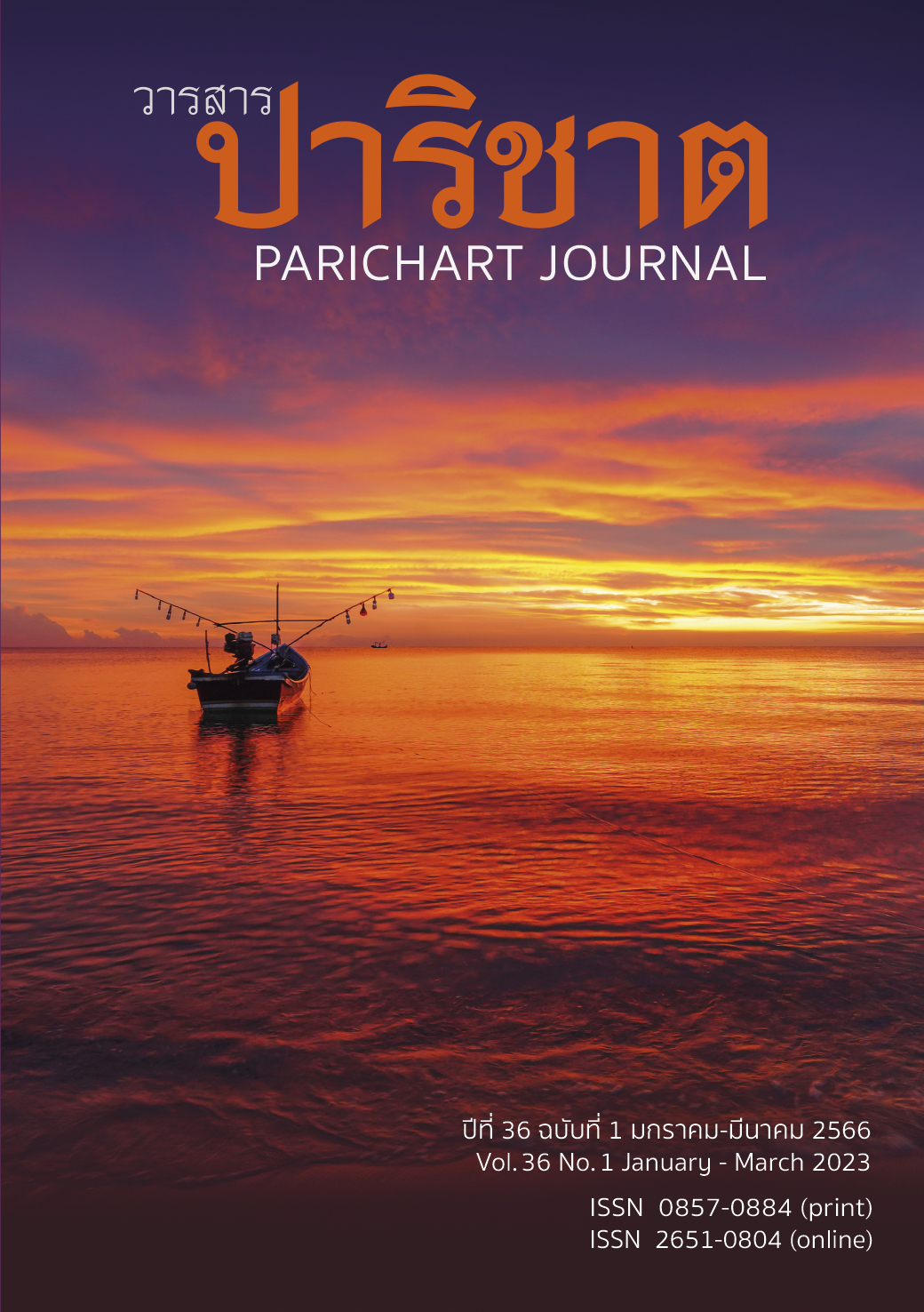The Narratives of the War between Siam and Saiburi: Content and Cultural Meanings
Main Article Content
Abstract
This research paper aims to study the content and cultural meaning of the narratives of the war between Siam and Saiburi. It is a qualitative research, according to research methodology in folklore field. Data was collected in Nakhon Si Thammarat, Phatthalung, Trang, Songkhla and Satun provinces, along with collecting document data for the study. The results of the research revealed 56 the narratives of the war between Siam and Saiburi, classified into 3 groups: 1) telling the events before the battle 2) telling the events during the battle, and 3) telling the events after the battle. The content of these narratives also has cultural meanings that show ideas, beliefs and relationships among people in the Thai-Malay peninsula in 4 key themes: 1) relationship between narratives and local names and landmarks. 2) the ancient path marching route and the path of pilgrimage same line. 3) Muslim settlement and cultural integration in the southern region, and 4) the negotiation of power relations between the Siamese and Malay states. This study indicates that in the local narratives, which are often based on events believed to have happened in the local area, most of the important events in the story are reliable information. The narrative also carries cultural connotations that represent people's thoughts, beliefs, and imaginations.
Article Details

This work is licensed under a Creative Commons Attribution-NonCommercial-NoDerivatives 4.0 International License.
References
Lomlim, T. (1972). The relations between Siam and her Malayan tributary states in early. Bangkok period (1782-1868). [Unpublished Master’s Thesis, The collage of Education].
Phra Kru Kantayaphiwat. (2020, August 17). Personal interview [Personal interview].
Eawsriwong, N. (1993). 8th Puey Ungphakorn Keynote Presentation. Faculty of Economics, Thammasat University.
Nimmanhaemin, P. (2002). Study folk tales. Faculty of Arts, Chulalongkorn University.
Na Thalang, S (Editor). (2015). Thai Folktales in a changing world. Sirindhorn Anthropology Center (Public Organization).
Choowan, Y. (2019). Rescue a Thai Local history. (2nd edition). Gypsy Group.
Eawsriwong, N. (2000). Krung Taek, King Tak and Thai history: on history and thesis history. Matichon.
Hatyaifocus. (2021). 2 The legend of Ban Phangla, Sadao. https://www.hatyaifocus.com/article/629-Hat Yai story-2-Legend-BanPhangla-Sadao/
Ministry of Tourism and Sports. (2021). Holy Well (Wat Semachai). https://thailandtourismdirectory.go.th/th/attraction/21532
Kraisin, S. (2021). Tha Samet is number one. Cha-uat is one of them. https://www.facebook.com/imvanpra/posts/10208565551692230.
Rittapirom, B. (2009). Knowledge of the legend of To na na Satun's great-grandfather. Satun Provincial Administrative Organization.
Memoirs of Plub Chaiwong. (2002). (n.p.)
Phrakhru Prayut Thammarat. (2022, January 15). Personal interview [Personal interview].
Sukrakarn, C. (1998). Ban Khan Thong. Sara Nakhon Si Thammarat, 28(6), 34-36.
Thurajan, A. (1978). History of the names of sub-districts and villages in Mueang Nakhon Si Thammarat District.Nakhon Si Thammarat Province. [Unpublished Master’s Thesis, Srinakharinwirot University].
Nakhon Si Thammarat Teachers College. (1988). Report of the 4th Nakhon Si Thammarat History Seminar: Art and Culture of Nakhon Si Thammarat and the Economic and Social Changes of Nakhon Si Thammarat. Nakhon Si Thammarat Teachers College.
Sangmanee Sirisatikit, C. Garudajon, T., & Sirisatikit, P. (2019). The Buddhism merit road of Siamese in Malaysia: An analysis of Thai and Malaysian cultural common heritage. Inthanin Thaksinsan, 14(1), 9-41.
Phasuk, S., & Stott, S. (2004). Royal Siamese maps, war and trade in nineteenth century Thailand. River Book.
Luang Udom Sombat. (1987). Royal Letter Udom Sombat: Along with descriptions of Krom Phraya Damrong Rajanupap. Fine Arts Department.
Chanthamat, S., Janong, C., Nongma, W., Chanseng, S., & Saengmanee Sirisatikit, C. (2021). Tradition of two religions in multicultural society to encourage the strengthening of community: A case study of Tamod Community,Tamod District, Phatthalung Province. http://www2.huso.tsu.ac.th/ncom/csd/csdful_pdf/c120.pdf.
Sangthong, P., & Taechuan, B. (2020). Literature and cultural integration: An analysis of roles. and the value of fiction, poems, stories "Mueang Sid-Mahawe" in Charat Community, Kong Ra District, Phatthalung Province. Journal of the Faculty of Humanities and Social Sciences. Prince of Songkla University, Pattani Campus, 16(2), 67-94.
Wirunha, C. (2008). Some thoughts on Thai-Malay relations. in the historical dimension. http://www.openbase.in.th/files/ebook/textbookproject/tbpj213.pdf
Samutgupta, S., & Kitiasa, P. (2001). “Yuan Sikhio” in ethnic junctions: stories, memories and identities of the Thai Yuan ethnic group in Nakhon Ratchasima Province. Suranaree University of Technology.
Nammontree, N. (2015). The narratives of Thao Suranaree : The construction of cultural landscape by the Thai-Khorat in Nakhon Ratchasima in the context of contemporary Thai society. [Unpublished Doctoral dissertation, Mahasarakham University].
Halbwachs, M. (1992). On collective memory. The University of Chicago Press.
Naksithong, P. (2005). The study of Luang Udomsombat's dispatches as a historical document. [Unpublished Master’s Thesis, Srinakharinwirot University].
Misztal, Barbara. (2003). Theories of social remembering. Open University Press.
Sangkharat, U. (2015). From the memory area : To the historical community area. in Lertchai Sirichai and Suwit Maprasong (Ed.). Meaning on the way : A synthesis article of young research, local history studies. (pp.147-200). Research Fund Office.


